Ep. 25: AKIRA vol. 2 by Katsuhiro Otomo
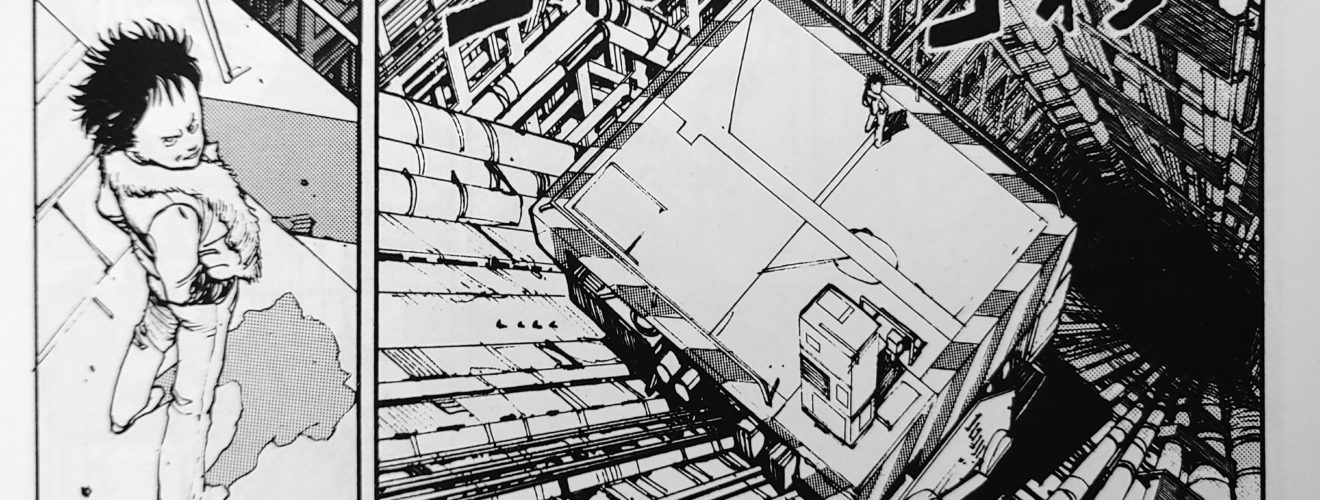
As we wrap up Season 1 of Mangasplaining, we return to where we started, with the second volume of Katsuhiro Otomo’s epic manga creation, AKIRA. AKIRA Vol. 2 is a great manga that acts as a jumping-off point for a wide ranging talk on printing and publishing, assistants, and art vs. commerce. It’s a very big episode, we hope you enjoy it!
Powered by RedCircle
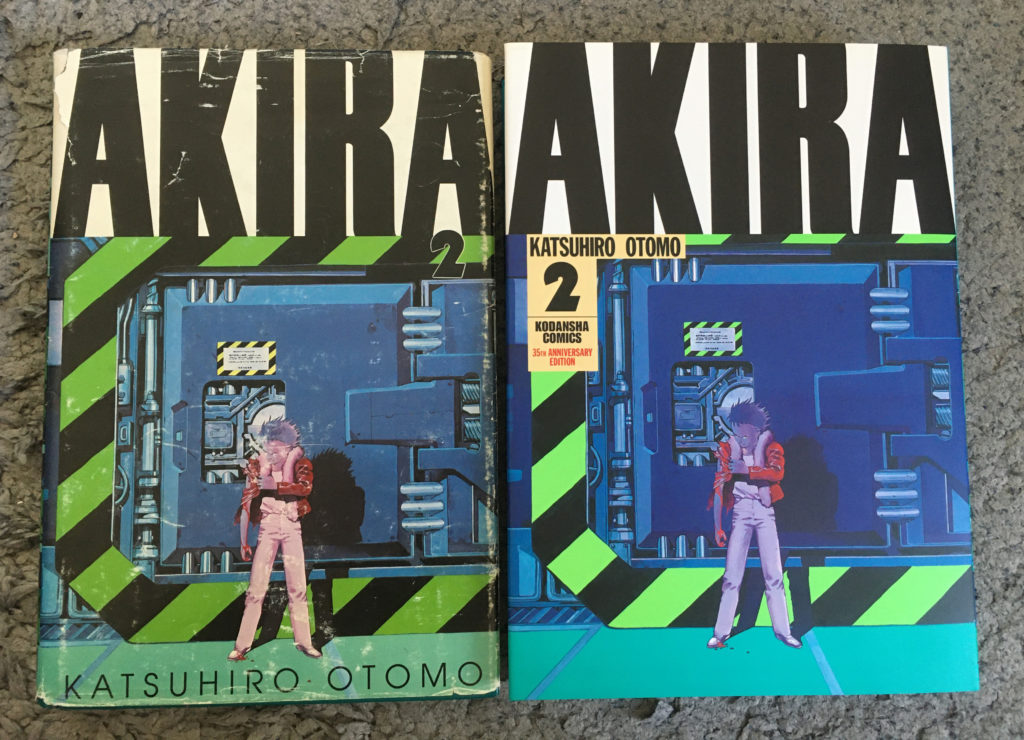
AKIRA Vol. 2
By Katsuhiro Otomo
Translation and English Adaptation by Yuko Umezawa, Linda M. York, and Jo Duffy
Translation Adaptation by Stephen Paul
Kodansha Edition Lettering by Scott O. Brown and Evan Hayden
Editing by Haruko Hashimoto
Published by Kodansha Comics (Print only)
00:00: Before We Start: SPOILERS. For the manga and the anime.
While putting the show notes together, I was reminded, again, that there’s no digital format version of AKIRA (due to the author’s wishes…) and it makes getting images here kind of a pain in the butt… but we do it for you! 😀
It’s also worth noting that we flip back and forth between talking about three different editions of AKIRA, the Marvel color editions (with Steve Oliff), the Dark Horse Black & White edition with the French-language sound-effects, and the most recent Kodansha hardcover edition, with Japanese sound effects. We don’t dig into explaining these quite as in depth as we did in volume 1, so maybe go check out the show notes for v1 for more info.
Finally, there’s some gory art in these show notes. Discretion is advised.
1:45: Pretend we inserted the Duel of the Fates music here, after the ‘personality clash’ thing David said.
02:00: We covered so much ground in the first AKIRA episode that we were still dropping AKIRA knowledge into the next episode, Delicious in Dungeon.
03:42: The platform elevator is just badass, and they use it to great effect throughout the entire volume, more or less.
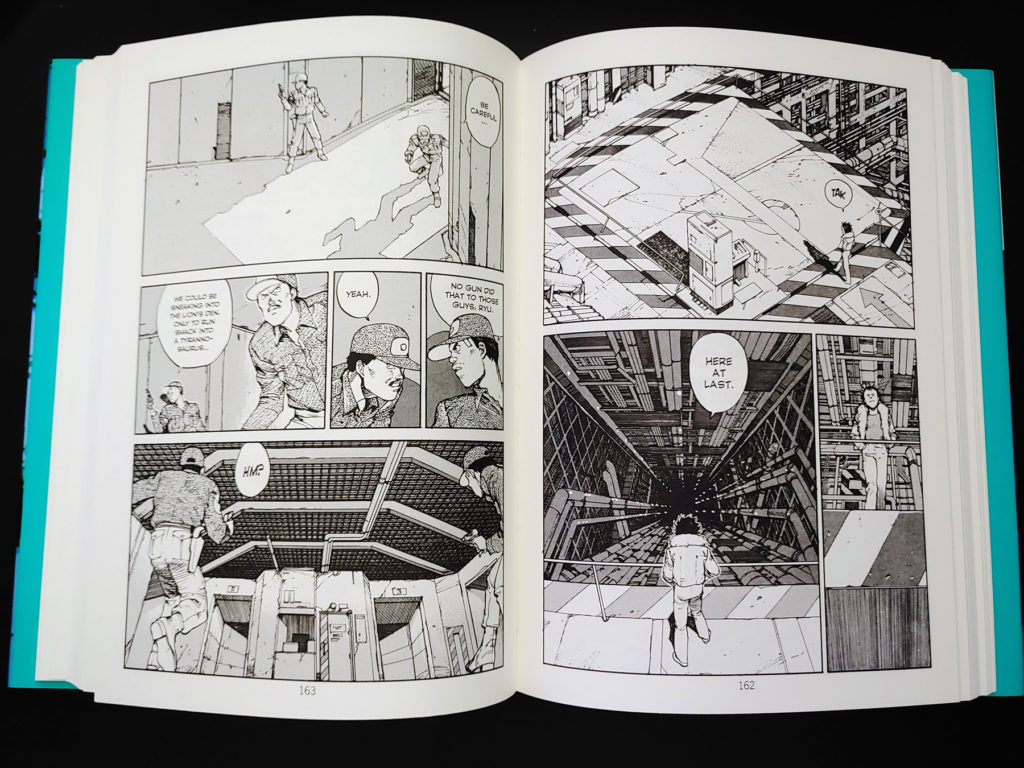
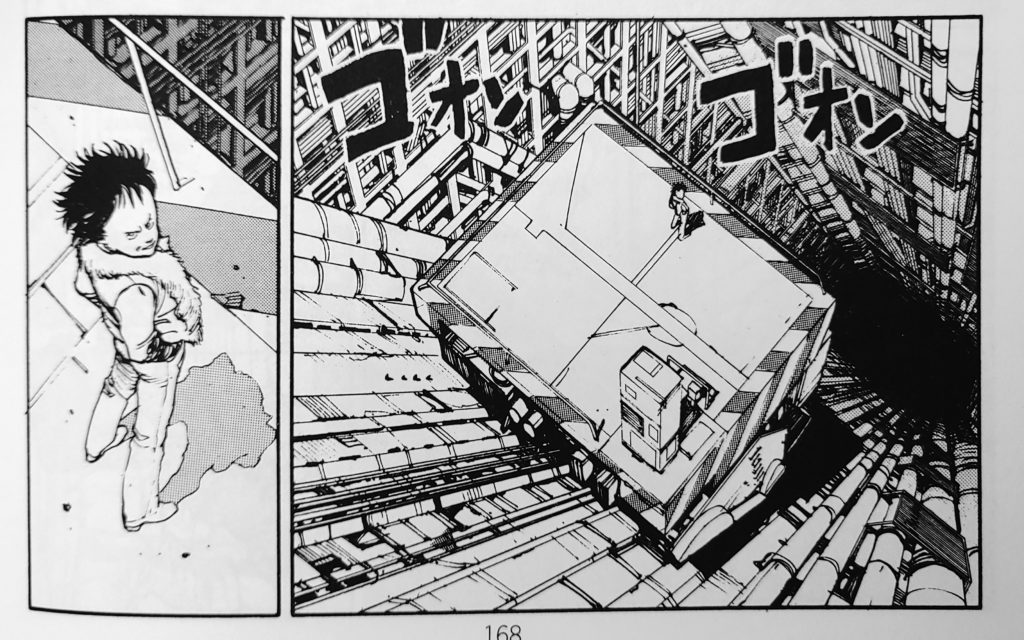
05:22: We should have just ended the episode here and then come back. 😉
06:25: Kaneda IS on fire this volume, and the bit with the laser is such a good gag.
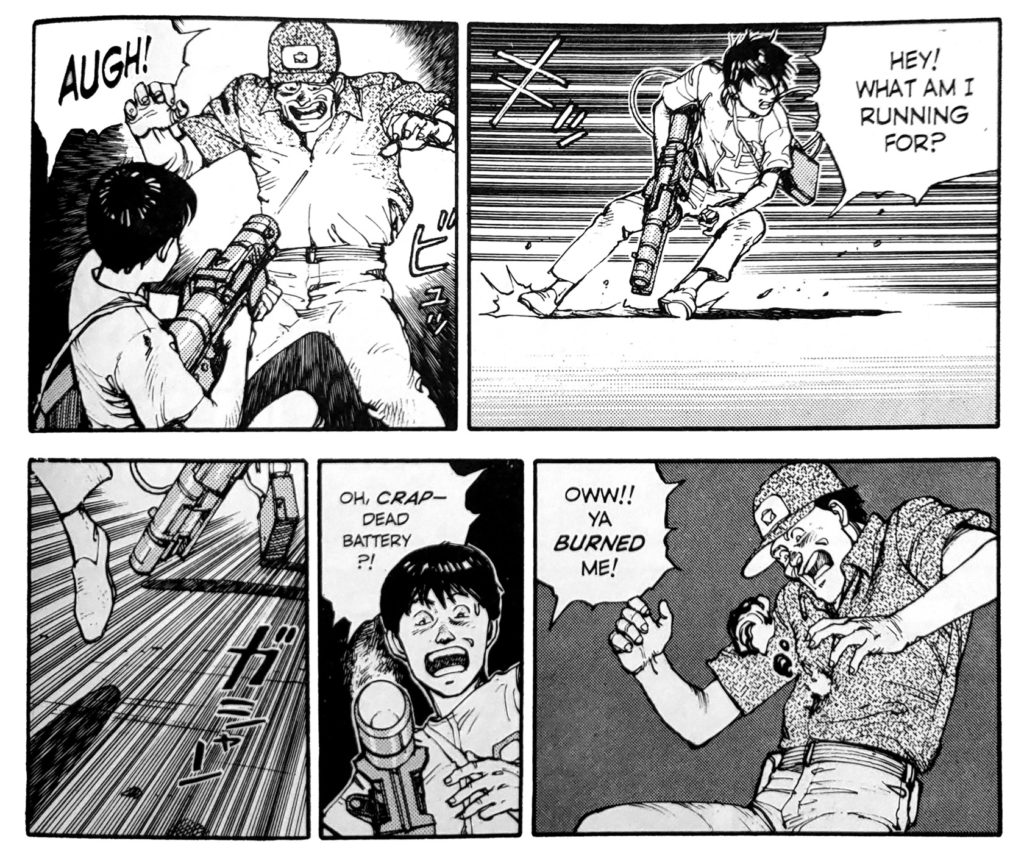
08:10: Yeah that trope of having a hole blown right through someone, and then you see their face on the other side, is still a banger piece of visual language. It’s still a bit unsettling though. Here’s the cover image that David mentions, to the third issue of Miller & Darrow’s Hard Boiled. It’s an interesting note, in light of what David and Chip are saying, that the gross body horror sequence at the end of the film AKIRA has no blood at all, just sort of gross flesh.
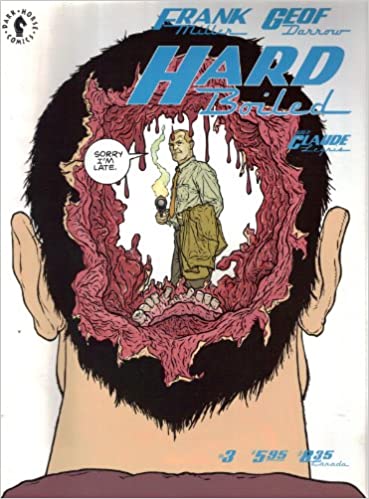
08:20: The scene I’m talking about is, of course, when The Bride fights the Crazy 88 in Kill Bill, and there’s so much arterial spraying of blood that they make the sequence black & white as an homage and to get the film rated by the MPAA. Here’s a link to that fact on IMDb. I guess like everything on the internet, take it with a grain of salt. https://www.imdb.com/title/tt0266697/trivia?item=tr0790531
And although it’s a helluva tangent, here’s that scene as it appeared in North America, with the scene turning to B&W…
…and here’s the scene in colour thanks to fans who have a LOT of time…
08:55: It’s true! The SNES edition of Mortal Kombat was very, very sweaty… You can read a whole article about it here. https://www.syfy.com/syfywire/how-mortal-kombats-super-nintendo-debut-changed-video-games-forever
09:05: Meanwhile, Deb is referring to the ways in which the Pokemon anime was censored/edited/clumsily-localized for North America during the first season so as to remove more obvious references to Japanese culture, and “Americanize” them. The most infamous of which is Brock pointing to onigiri–balls of rice wrapped in seaweed–and calling them jelly-filled donuts.
Sadly this kind of extremely dumb localization continues today. You can google “Brock Jelly Filled Donuts” for the full story, but check out this article on the most recent attempt to ‘sell’ the popular Doraemon franchise in North America. https://www.animenewsnetwork.com/news/2014-05-11/doraemon-anime-visual-and-script-changes-for-u.s-tv-detailed

11:05: This is the scene Deb is talking about. It really is subtle, Kei’s demeanor changes and the reveal that she’s being controlled by the kids really is masterful.
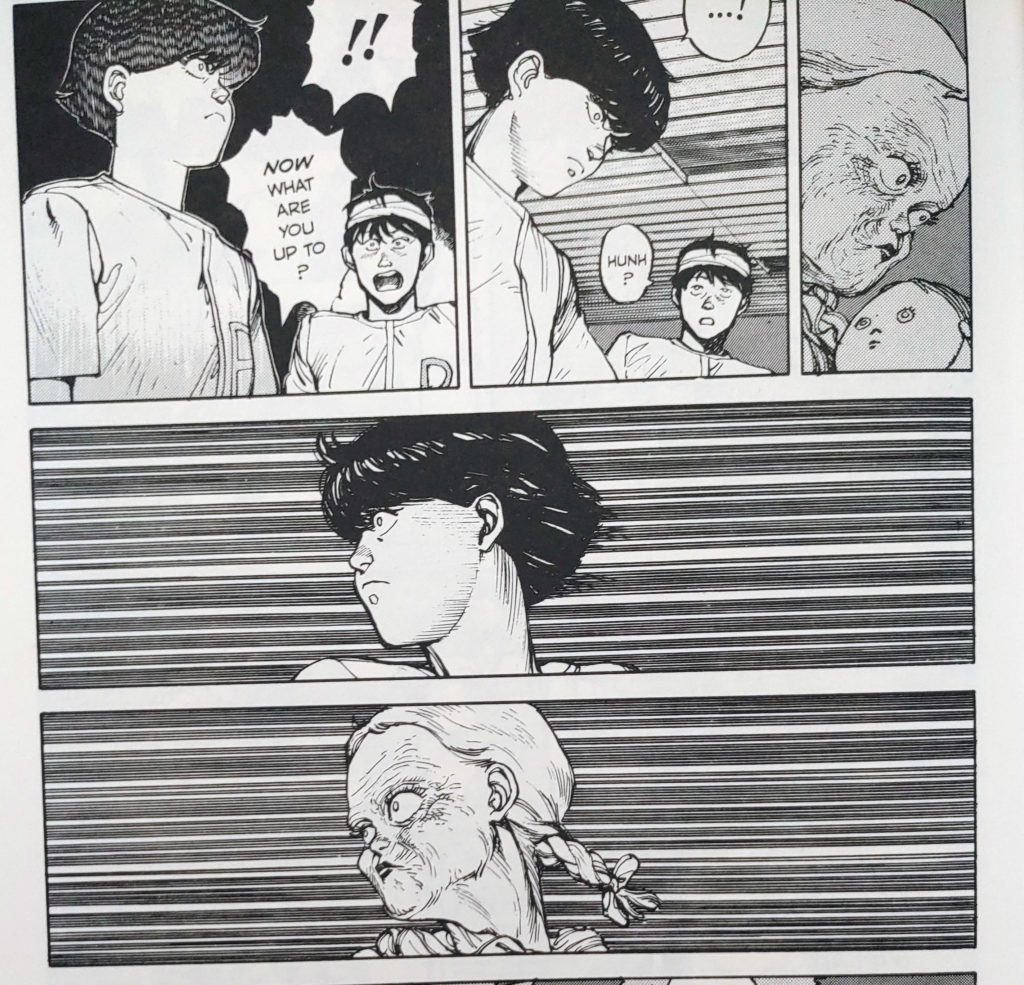
12:05: SAFE!
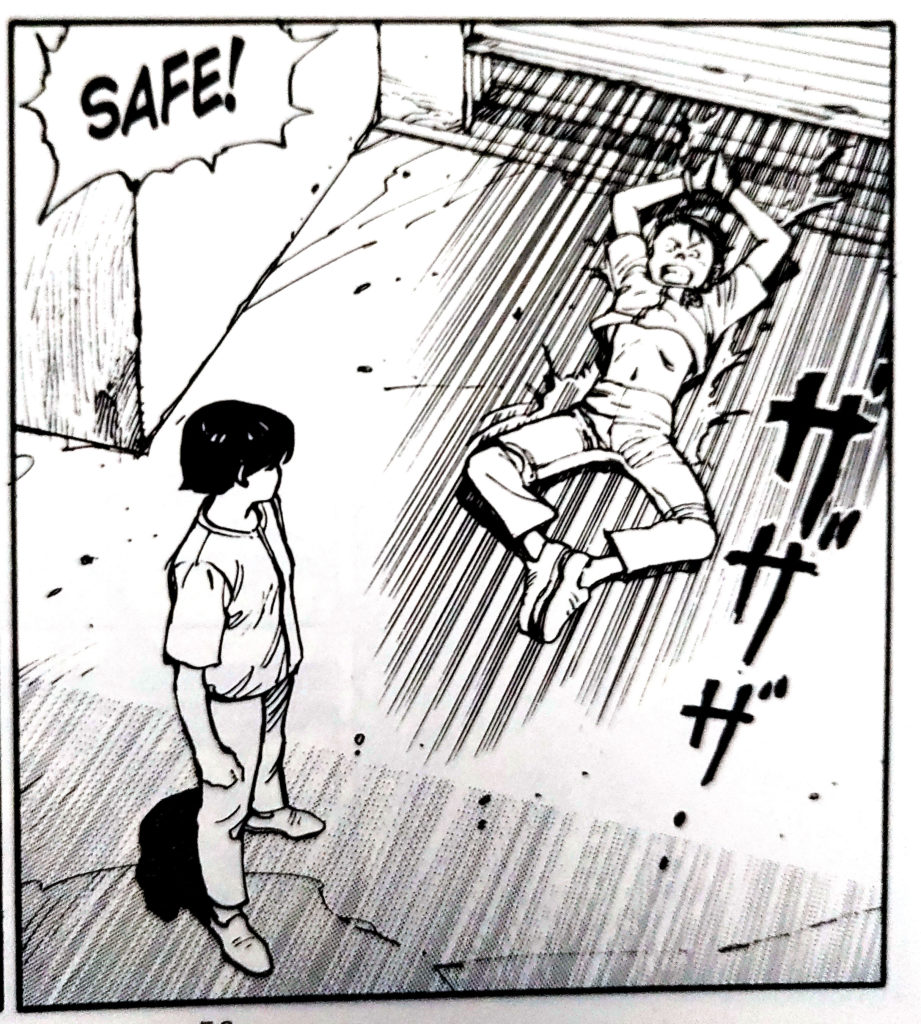
14:00: The really are just a few ‘sets’ in AKIRA Vol 2, as it starts with the characters all moved to the military facility that contains the kids, then a quick stop at base before they’re back in the sewers for a sequence, and finally the underground base with that awesome elevator, and finally the exterior ‘wasteland’. It’s overall a much, much tighter, and quicker, volume than the first.
19:44: Teenage me liked this sequence.
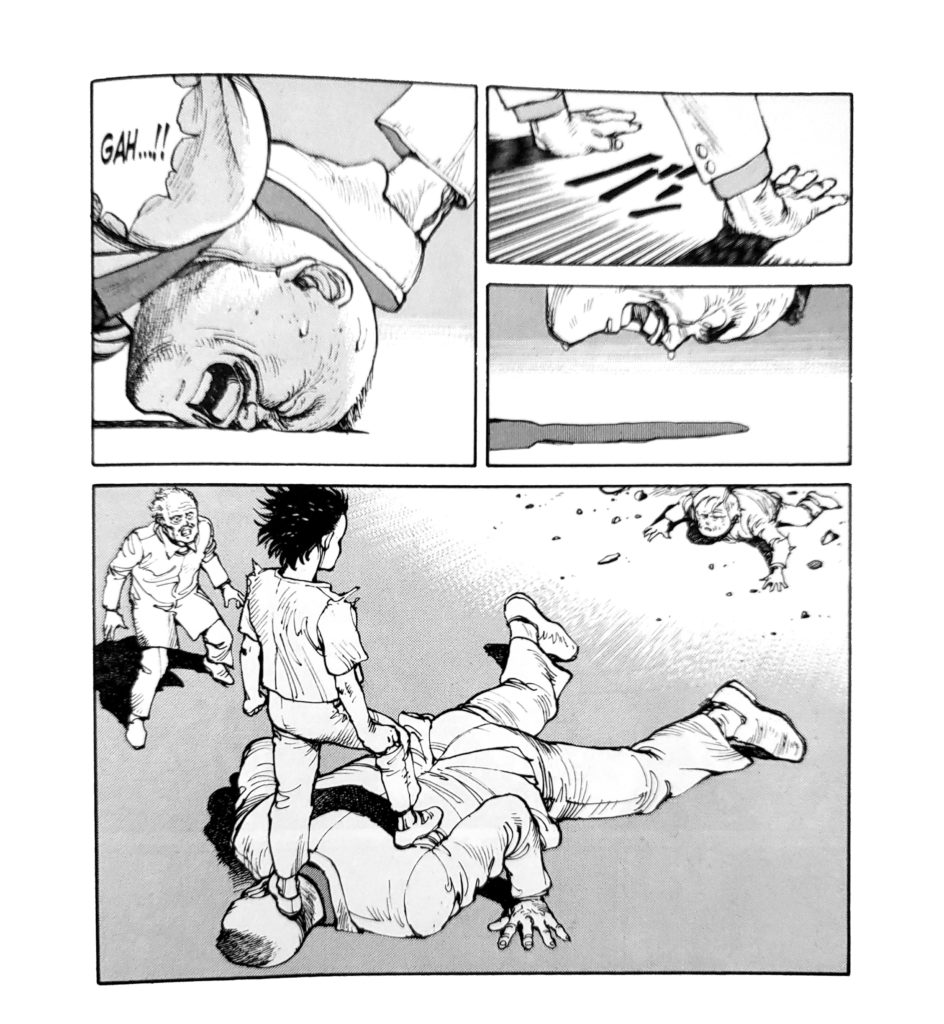
21:45: Chip’s still not on board with the colour, even this very pretty sequence of Akira coming up out of the containment chamber.
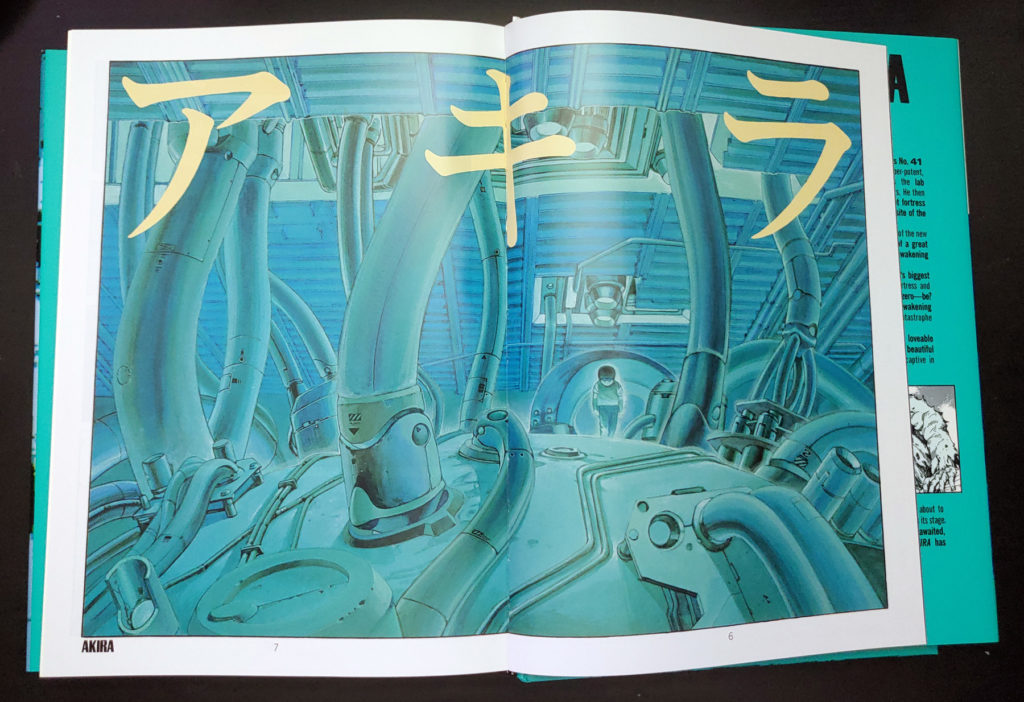
But here’s something interesting…
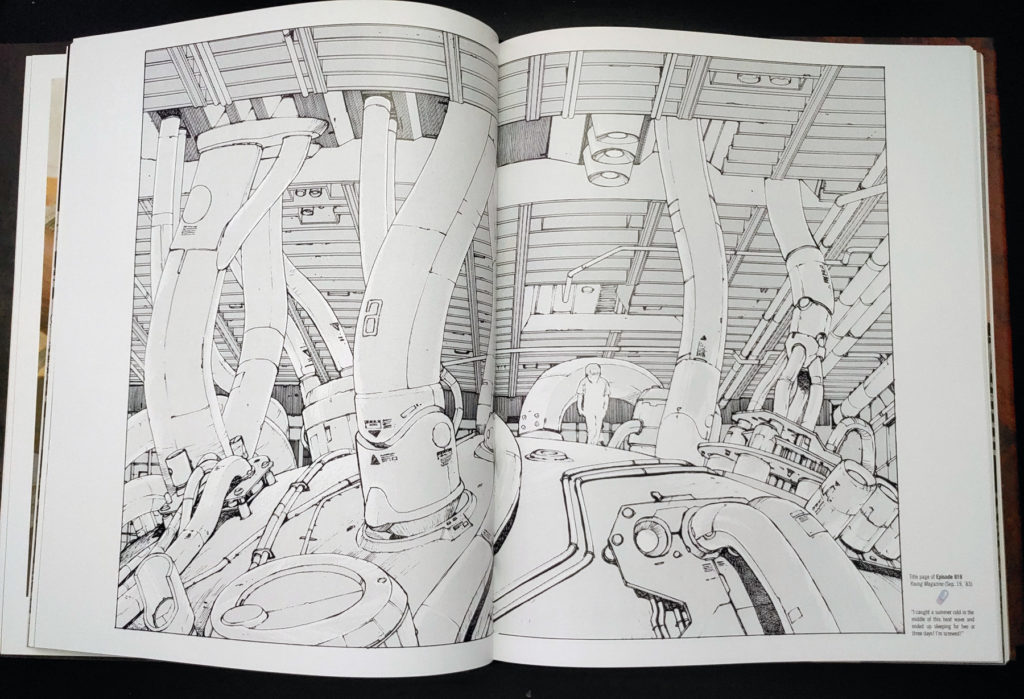
The painted sequence that starts this volume, this double page splash, is actually a painted-over version of the black-and-white illustration used for one of the chapter title pages that’s in volume 2. I think I’m with Chip here in that the B&W works better to my eyes, but there’s a lovely ethereal quality to the paint I still enjoy. Photo from the book AKIRA Club, which we talk about more in a few paragraphs.
22:15: The endpapers are kinda nice, but these might actually come from a previous edition? Or maybe straight from Japan? I wonder if those are Steve Oliff’s marker layouts? They’re uncredited.
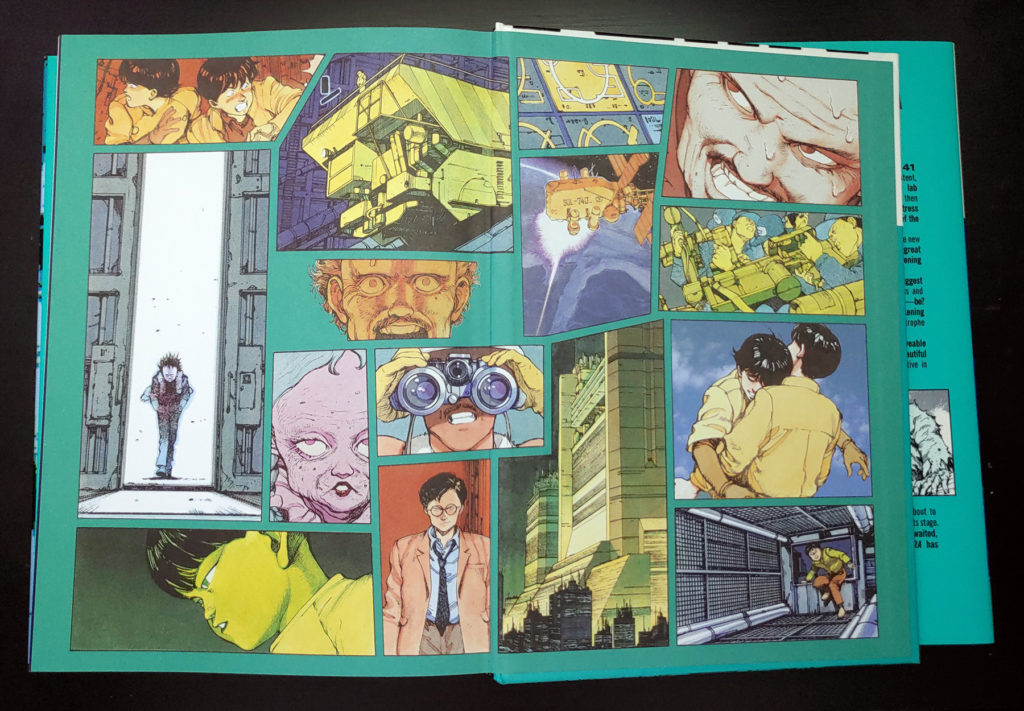
24:30: Interestingly, and we don’t maybe mention this anywhere else, but in the original serialization of AKIRA, each chapter had a title-page illustration separate from the story. Sometimes it could just be an extra splash page, sometimes it would be a stand-alone illustration, but yeah, there were clear chapter breaks with really nice illustrations. In the collected editions of AKIRA, and that’s all of them by the way, those illustrations are not, generally, included anywhere in the manga volumes. The stories just run without chapters, as a continuing series of events in ‘graphic novel’ form, with the only ‘breather’ coming at the end of a physical volume.
But! As Deb mentioned, those illustrations are preserved and reprinted in the art book AKIRA CLUB, which was a stand-alone art-book that Dark Horse did a couple of English editions of back in the day, but as of writing, that book is ONLY available as a bonus book in the AKIRA Box Set, published by Kodansha.
BUT! When the series was brought to North America, usually the Marvel Comics editions of AKIRA would use those illustrations as the covers to individual issues, and they’d get the same colour treatment as the interiors. I say usually because sometimes they’d opt to use a panel/page from the book instead.
So David’s “Graphitti Editions Hardcovers” that he’s mentioning, which collect the Marvel comics single issues, do seem to include some of those leftover colour pages as bonus material, or backmatter, but clearly not all of them… and they seem to include them while NOT including some of the original painted artwork! Here’s the weirdest part, though: That original painted artwork was included in the printed Marvel Comics! It’s true, for whatever reason, it seems like the Graphitti Hardcover edition just… left those paintings out. Wild.
Oh weird. I just did a quick web search and apparently Graphitti Designs still has volume 4 of the colour edition in stock… at cover price… 30 years later? Dang.
Anyway, the short version is: The publication of AKIRA in English is very, very weird, and you can kind of see why Otomo wants to release a perfect edition of his works at some point in the future.
And, keep listening. It gets weirder.
30:30: The AKIRA film released in 1987 and 1988, and the AKIRA manga finished in 1990, fwiw.
32:00: That book Christopher mentions, that Deb mentioned, is Jiro Taniguchi’s A Zoo In Winter, which is a thinly-veiled autobiography about the artist becoming a mangaka. It’s not bad, 7-10, but great insight into making manga.
34:45: Tetsuo Hara (1961-) is the creator of Fist of the North Star, and he is in fact 59 years old as of writing. https://en.wikipedia.org/wiki/Tetsuo_Hara. After many, many years FotNS is now back in print in very nice hardcover editions from VIZ Media.
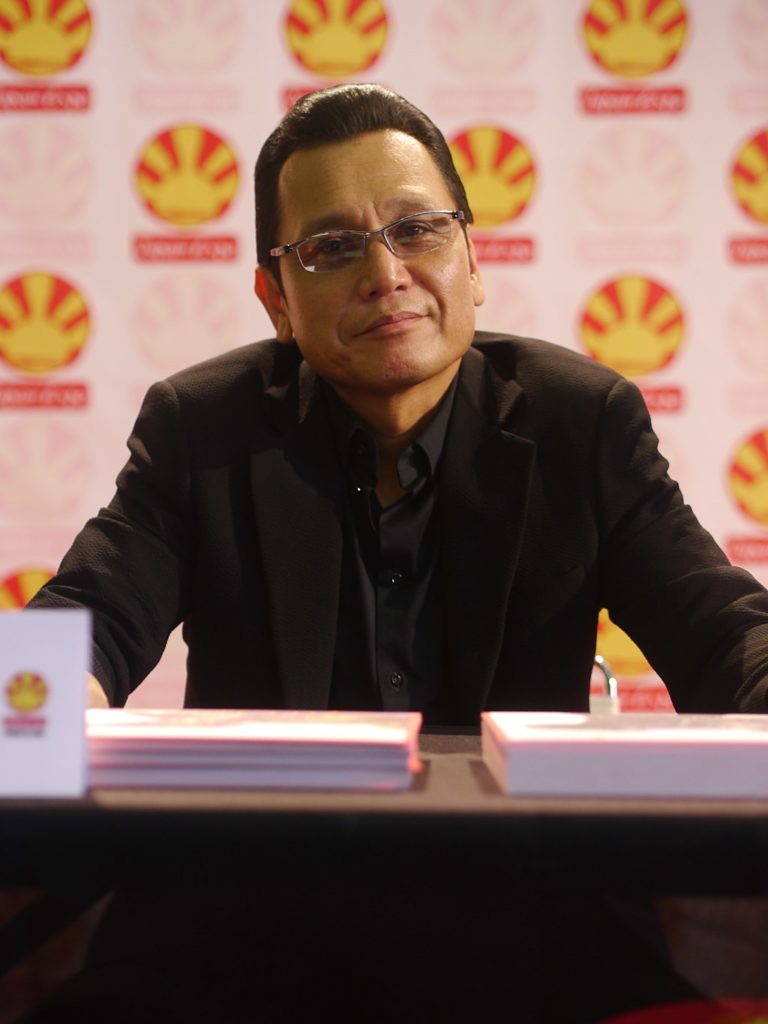
Also as a nice little addition, I found this interview between Tetsuro Hara, and recently deceased Berserk creator Kentaro Miura that we just mentioned. Happenstance! If you’re a fan of either creator, you might want to give this a read.
36:45: This is the image I mentioned, from the Naruto chapter page.
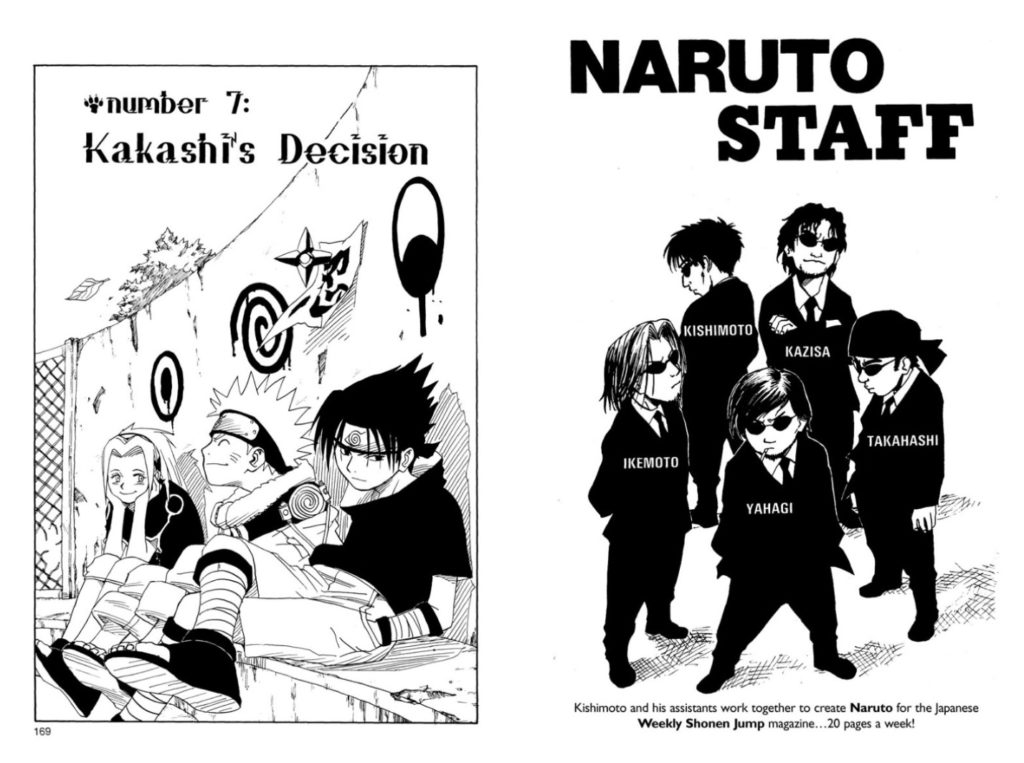
37:00: Since we’re talking about assistants here, I should note that according to Otomo himself he only used two assistants on AKIRA, and I believe those are the folks credited on the MASH-ROOM page, Makoto Shosaki and Yasumitsu Suetake. I got that info, btw, from this ‘unofficially translated’ interview between Otomo and Vagabond and Slam Dunk creator Takehiko Inoue at Mangabrog.
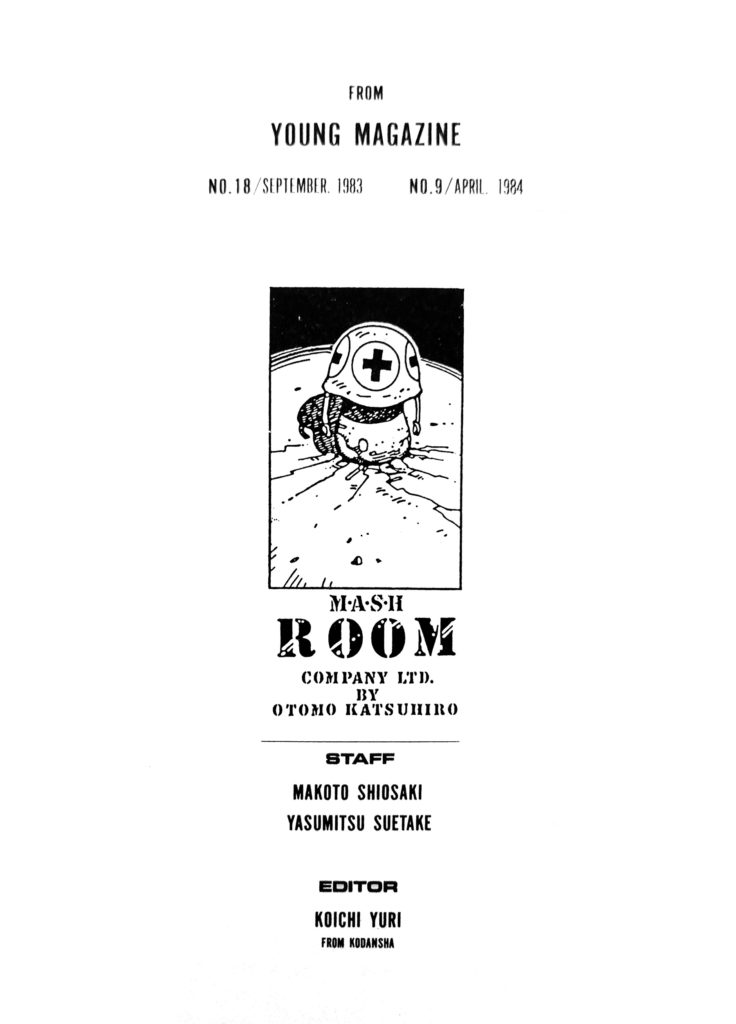
38:10: We mention manga and anime creator Satoshi Kon (1963-2010), who passed away in 2010 at the age of 47. A former assistant to Otomo and an amazing author and animation director in his own right, his work deserves so much attention, particularly if you like Otomo & AKIRA. A number of Satoshi Kon’s manga are in-print thanks to Vertical/Kodansha and Dark Horse, including Dream Fossil, Tropic of the Sea, and Satoshi Kon’s Opus. His films include Perfect Blue, Paprika, Millennium Actress, and more.
You can check out a 38-page preview of Dream Fossil on the Kodansha Comics website.
42:30: That book again is AKIRA: Art of Wall. It’s been “announced” and its even on Anime News Network, so hopefully I’m not in trouble. If this sequence from the episode disappears, well, you’ll know why. It really is a great, very long interview though. Highly recommended.
44:20: Hah! Neat. Deb mentions Takehiko Inoue, and I just found that Inoue/Otomo interview above. I’d like to say I planned that but I absolutely did not. 😉
44:30: So that series is AJIN: Demi-Human, by Miura Tsuina and Sakurai Gamon, and every volume has assistant credits! Very cool, and very rare! Here’s a link to a tweet with photos of that: https://twitter.com/acosmos/status/592006912683724800?s=20
It’s worth noting that I’ve heard of situations, direct from manga-ka, that assistants don’t always want folks knowing that they were assistants, because they work to stand on their own merits, or they don’t like the work they did (or the title they worked on!!), and it’s pretty safe to say that it’s actually a lot more complex of a situation than it’s often made out to be when talking about manga-ka assistants here in the west. Anyway, still cool that Otomo credited his two assistants, as well as Gamon on AJIN, presumably in all cases with their permission… despite what Chip says. 😉
45:15: Okay so here we go.
David notices that the pagination is one-page-off between the Graphitti Edition and the Kodansha edition! And that this might affect the (few) double page spreads that appear later in the volume. Like, this is some deep down forensic investigation of AKIRA publishing.
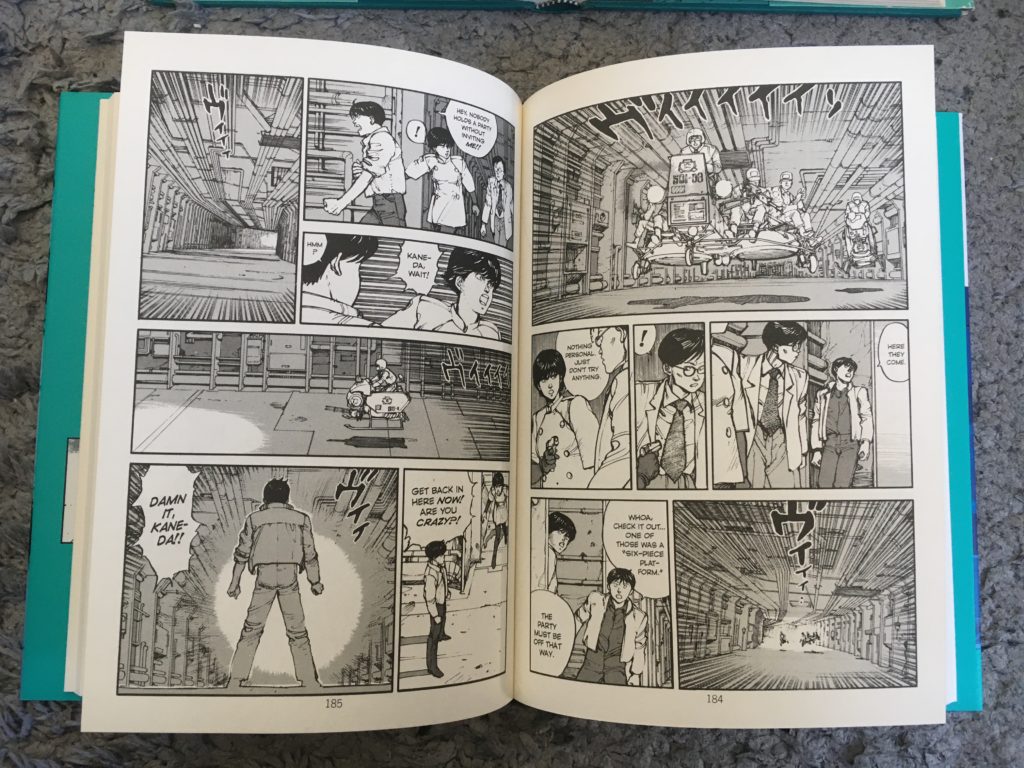
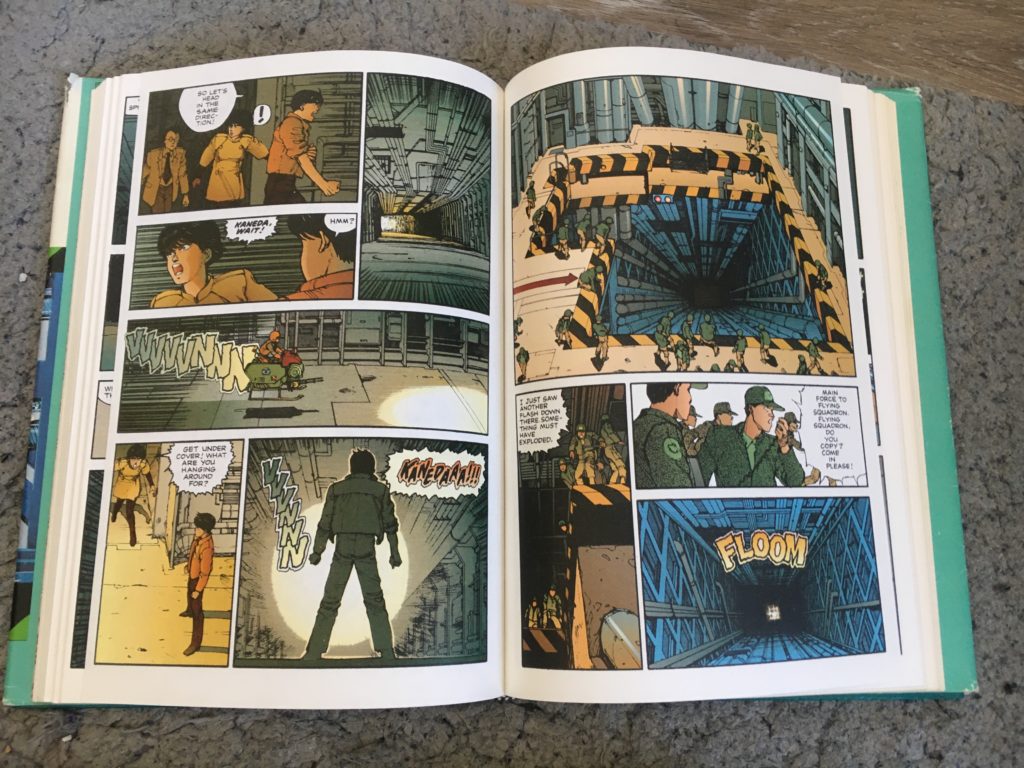
After the podcast was over, David actually went through page-by-page comparing the two editions, and found where Graphitti inserted the extra page to fix the pagination…! And after this page, it’s back in sync (though mirrored) from the Japanese edition.
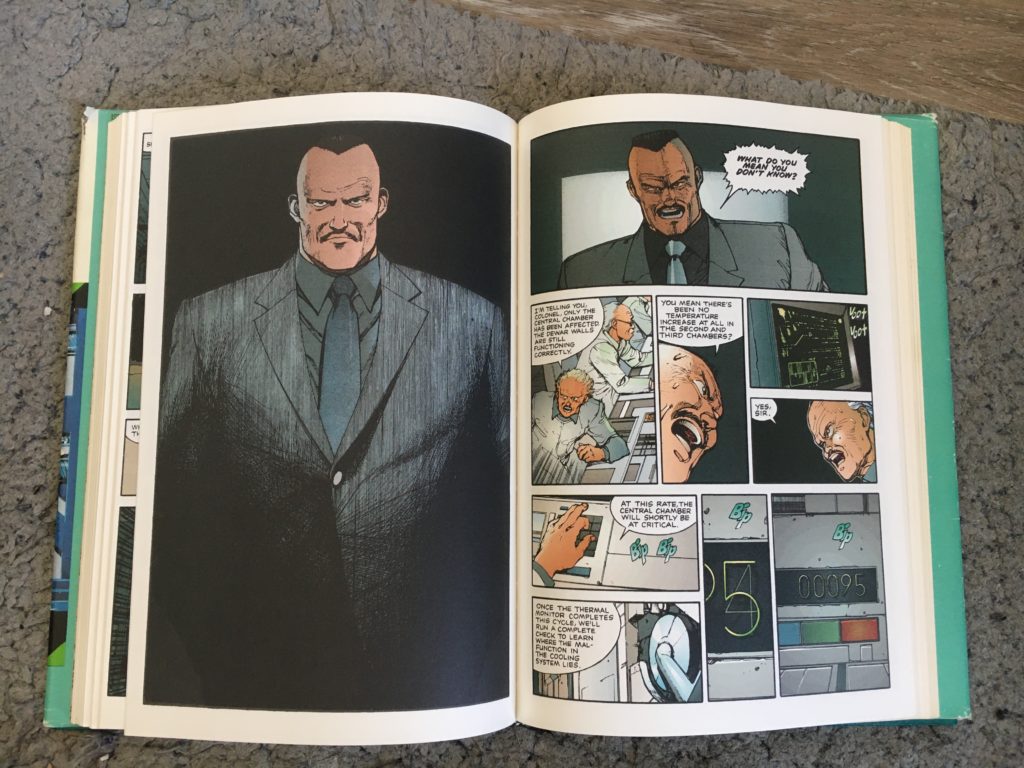
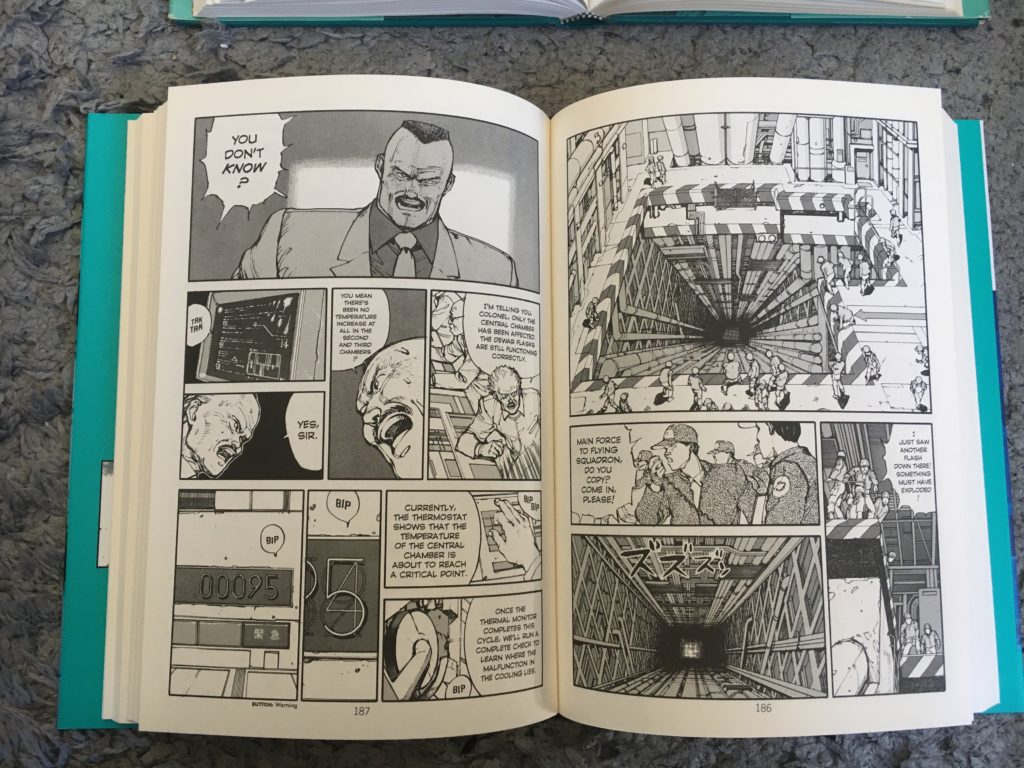
They inserted an illustration that ran as the chapter-title-page of episode 22 of the Japanese printing of AKIRA, and you can see a scan of the original page at ChonOtomo. http://chronotomo.aaandnn.com/1983/11/manga-akira-part-22.html
Or here.
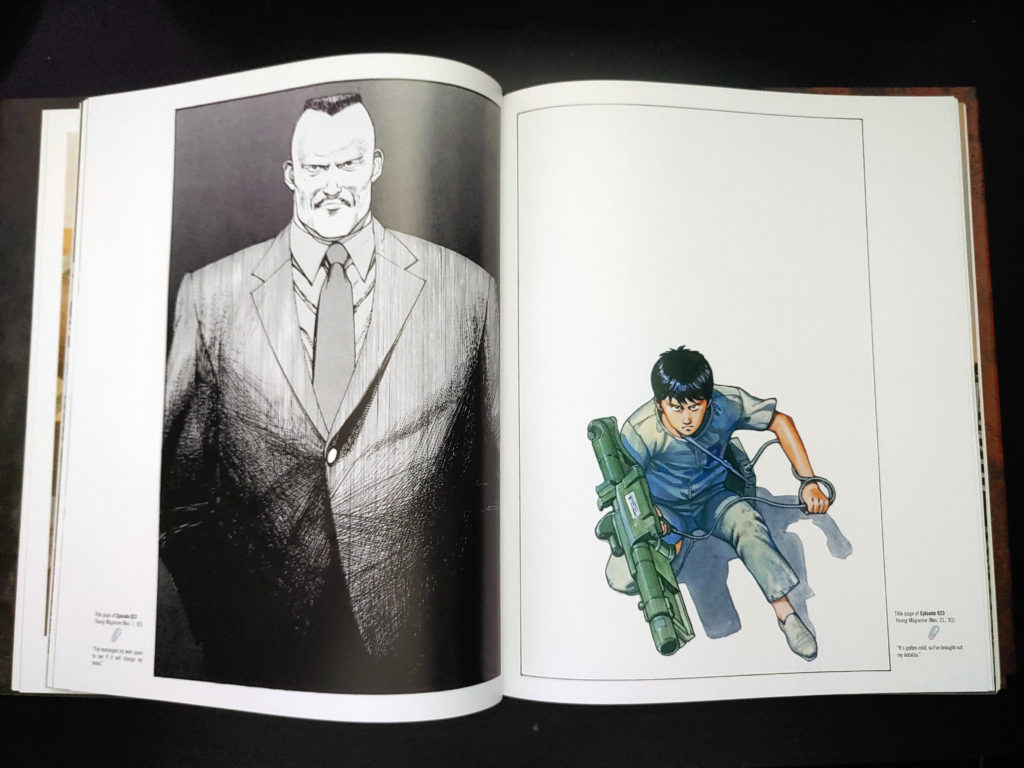
Interestingly, thanks to my good friend Gary (who has a complete run of the original EPIC/Marvel AKIRA single issue comics), I was able to confirm that this page, coloured by Steve Oliff, was never actually published in the Marvel/Epic editions, only making their appearance in the hardcover as a filler page…! Here’s a couple of photos of the original issues showing the ‘broken’ layouts, that don’t matter because they can change the starting page with each issue. Also, sorry for my hand and keyboard. ^__^;;
There’s even more weird technical stuff here too but we’re already PRETTY DEEP down the rabbit hole on this one. I will say the big takeaway for me is that it looks like Steve Oliff did actually color every single page of AKIRA, title pages included, whether they were included in the books or not. That’s pretty neat.
47:30: Since we mention the two double page spreads, I thought we should probably show you what they look like, they really are stunning and effectively used splash pages.
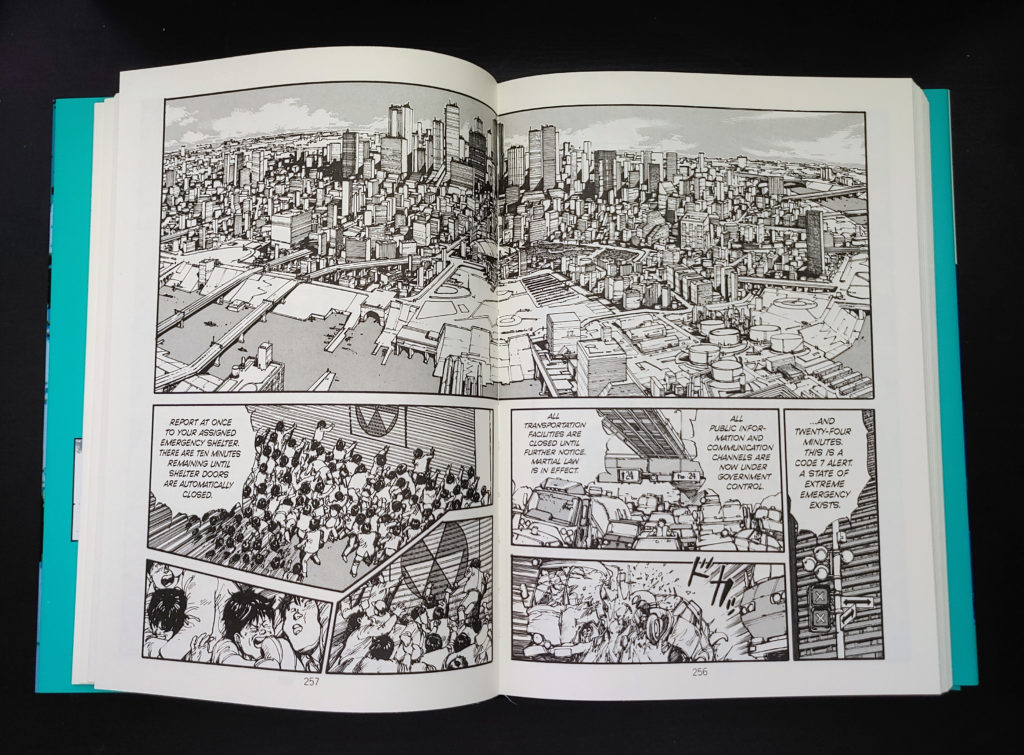
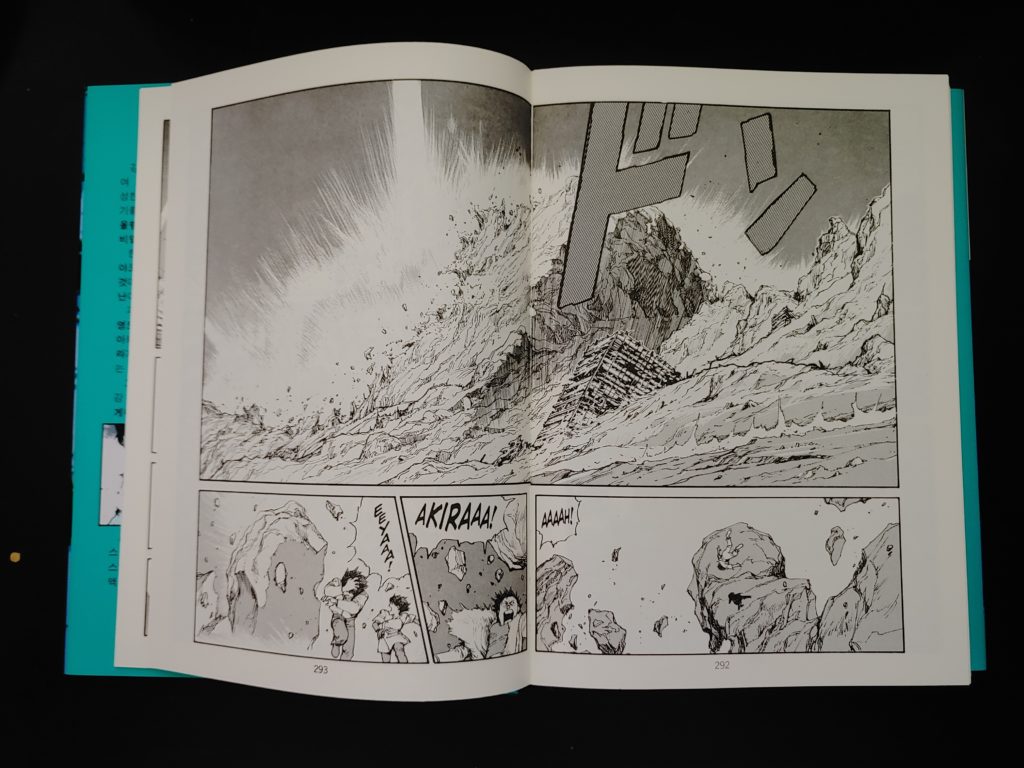
47:15: And as we mentioned at the beginning, spoilers, Tetsuo gets his arm shot off by a space laser.
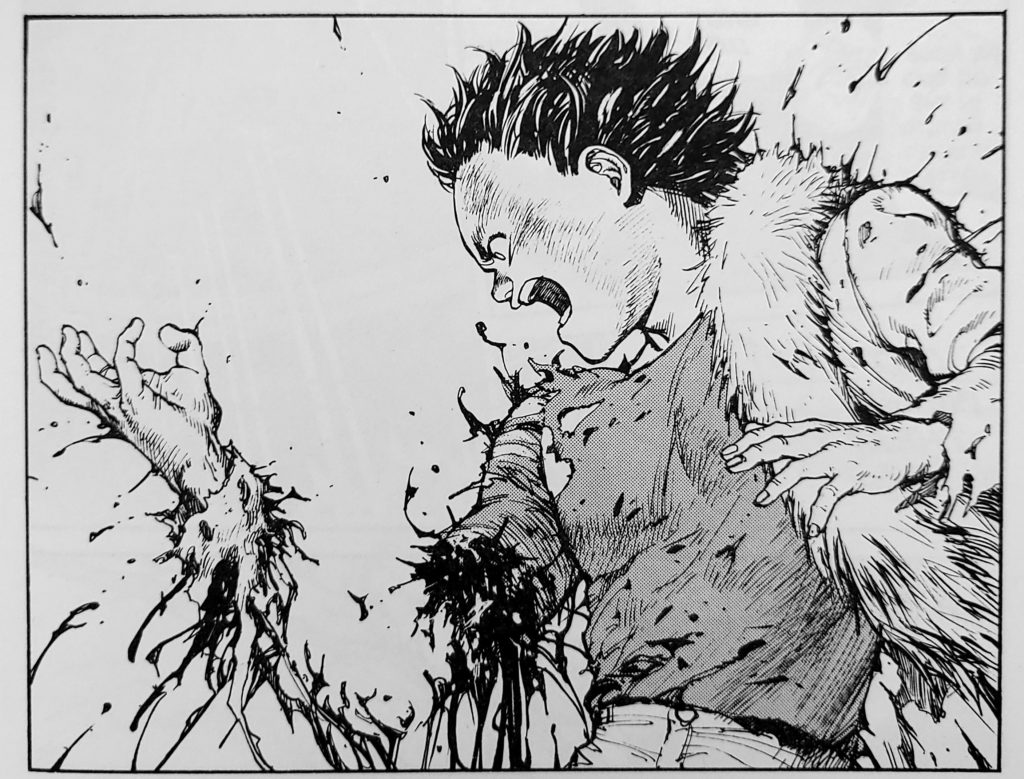
47:40: As a personal aside, the episode of Evangelion where Shinji crushes the entry plug that has [SPOILERS] in it and the episode ends with him screaming in existential agony fucked me up.
48:00: Deb mentions the chart that shows “Who was an assistant to who,” for Shonen Jump, and it is wild. Someone put an insane amount of work into this and I think I should probably just link it rather than pasting it in here, but it’s incredible. Go check it out on Behance.
52:30: Bryan O’Malley used a couple of assistants on Scott Pilgrim in the last few volumes, including John Kantz and Aaron Anchetta. I mistakenly identified Jason Fischer as an assistant on Scott Pilgrim, but he was actually an assistant on Seconds. Sorry for the error!
Bryan Lee O’Malley: https://www.instagram.com/radiomaru/
John Kantz: http://portfolio.jackmo.com/
Aaron Anchetta: https://www.instagram.com/anchet7/
Jason Fischer Kouhi: https://www.studiojfish.com/
53:10: David bleeped out the details of an error on a book he had to deal with as an editor, because it wasn’t germane to the point of the story, exactly. You’ll have to ask him in person (if we’re ever allowed to do that again) what the issue was. He may not tell you though! 🙂
54:54: THE BREAK! Please remember that after this point timestamps are approximate due to dynamic ad insertion.
Question of the week:
“I just finished listening to your Beastars episode and was curious about everyone’s comments on the art. You all talked about the Beastars creator being a sort of cartoonist/auteur, versus the writer/artist combo of Oishinbo. But I keep seeing at the end of manga volumes the creators thanking several assistants and you’ve mentioned previously that some assistants do backgrounds, inking, etc. So how much is it really a manga cartoonist doing all the drawing, and how much do the assistants do? Could manga volumes start ugly because it’s just the creator and then better when they can afford better/more assistants?
“Long question short, what’s the breakdown of duties between manga creators and their assistants, especially when getting chapters out on a weekly basis for some magazines? Are there manga creators sometimes doing all of the art like some western cartoonists?”
Luke Berger, Email
56:20: Naoki Urasawa is the creator of manga including 20th Century Boys, Pluto, Asadora, and much more. You can see a video of his manga process if you google ‘Naoki Urasawa Manben’, which is a show he hosts about manga creators, and he is the subject of one of the episodes. It’s grey-market, fan-sub’d material, although at this point is unlikely to be released in North America (I’d buy a DVD if it was…). Anyway, no links, but if you’re savvy you’ll find it.
[Deb]: However, Naoki Urasawa *does* have an official YouTube channel, where he posts videos, some have English subtitles too. Go to Urasawa Channel to see him draw and just gab about stuff.
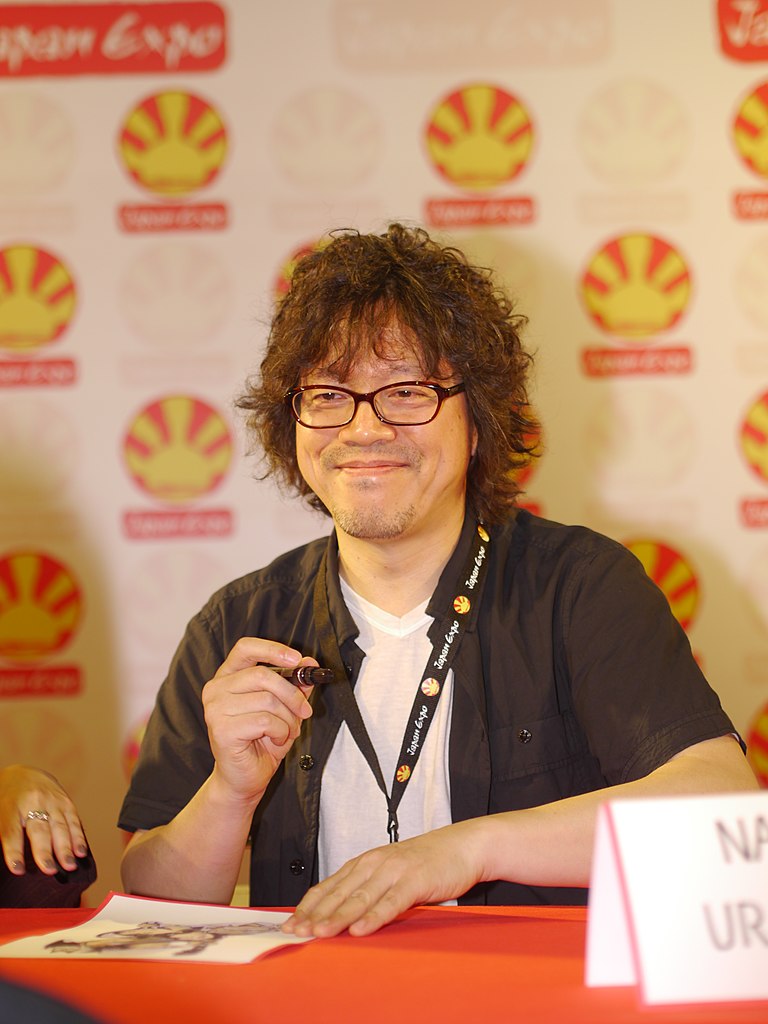
57:20: Shigeru Mizuki is the creator of Gegege no Kitaro, as well as the more personal books Onwards Towards Our Noble Deaths, Nonnonba, and more, published mainly in North America by Drawn & Quarterly. Deb mentions that Mizuki-sensei’s abilities were quite a bit different towards the end of his life and career, and sent us this auction for a ‘shikishi’ or signing board that he signed and did a quick illo on, and yeah, he’s just a different artist than he was.
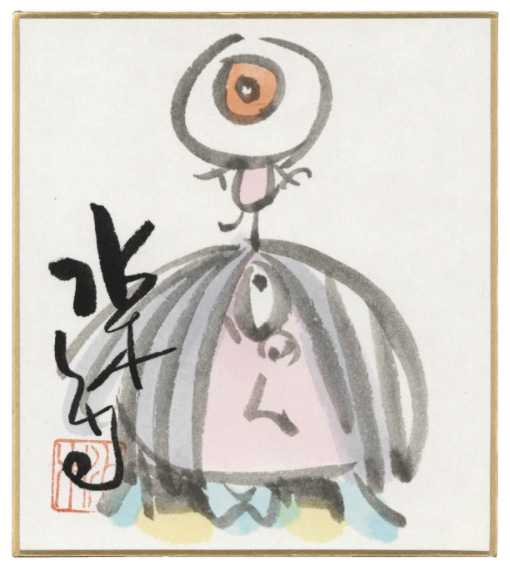
58:40: Takao Saito (1955-present) is the creator of Golgo 13, about an assassin who takes very specialized jobs murdering people. There are 201 volumes of Golgo 13 as of writing, and the series is still technically ongoing… since 1968! Only 13 best-of volumes have been published in English, and while they are all ‘technically’ out of print, I just checked Amazon and it looks like volumes 8, 9, 10, 11, 12, and 13 are all still somehow in stock, probably in somewhat limited quantities, for between $8 and $12 a volume.
Oh, and it looks like it’s on Kindle and Comixology, but not the VIZ app.
Also just as an aside, always check out the Japanese language versions of Wikipedia pages about manga-ka, there’s usually 10x as much info, and a lot more behind the scenes than we get in the west. No reason for mentioning this. 😉
59:00: As mentioned, many super-famous manga creators build up companies around them as they’re a bit further into their career, particularly if there are a lot of licensed materials to deal with. Takao Saito, Shigeru Mizuka, and Osamu Tezuka are just a few of the names of superstar creators that became industries. North American equivalents might be someone like Alex Ross, who has built a whole company around his work so that he can just paint and not have to deal with much beyond that.
1:01:14: ONE is the pseudonym of the webcomics Mob Psycho 100 and One Punch Man. The former has been published as trade paperbacks, in English, by Dark Horse Comics. The latter, One Punch Man, was re-written by ONE in partnership with artist Yuusuke Murata. That edition is published by VIZ Media, but unfortunately the original webcomic version has not been published in print in English, but you might be able to track down fan-translations.
1:10:00: Short Peace is the most recent animated film based on the works of Katsuhiro Otomo. An anthology film, it includes 4 shorts, each adapted from a different Otomo short manga story, each directed by a different director including one by Otomo himself.
Interestingly, one of the shorts, A Farewell to Weapons, was actually released by Marvel as a single issue. More on that in a future episode though!
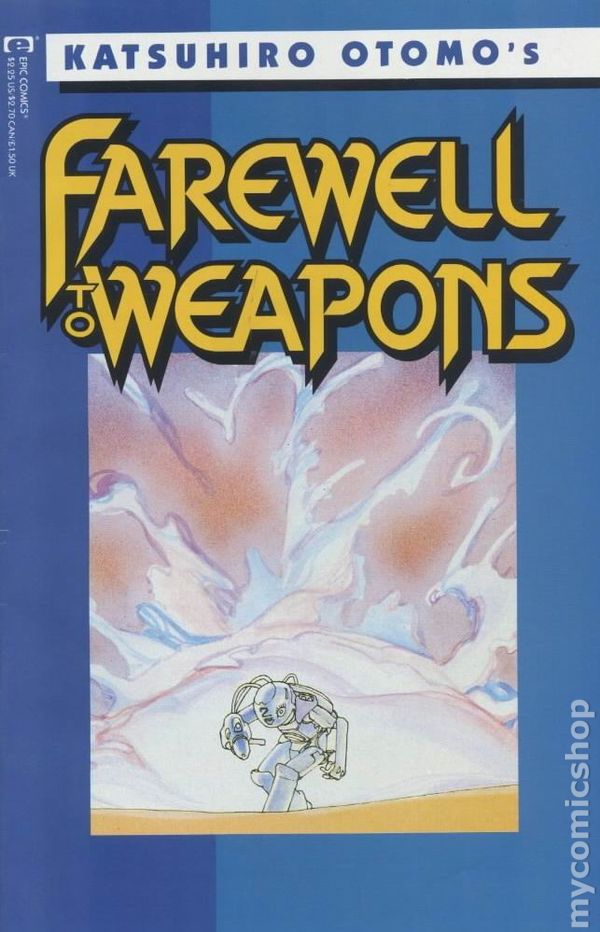
The Future of Mangasplaining!
So as we mentioned, we’re taking a few weeks off this summer (like Europe!) and coming back hard for the first week of September.
Here’s the next batch of Mangasplaining titles.
Season 2 Episode 1: Phoenix: Future, by Osamu Tezuka. Published by VIZ Media. (Sep 7)
(Christopher picked this 7 episodes ago!)
Season 2 Episode 2: Spy x Family Vol 1, by Tatsuya Endo. Published by VIZ Media. (Sep 14)
(Deb’s pick)
Season 2 Episode 3: Aposizms Vol 1, and Tsutomu Nihei smorgasboard. Published by Kodansha. (Sep 21)
(David’s Pick)
Season 2 Episode 4: An Invitation From A Crab, by Panpanya. Published by DENPA. (Sep 28)
(Christopher’s pick)
Good crop of books there, and more to come!
And as mentioned, we’ll see you back here next week for Mangasplaining Season 1 In Review. See you then!
—
Those links again are:
Thanks for listening!
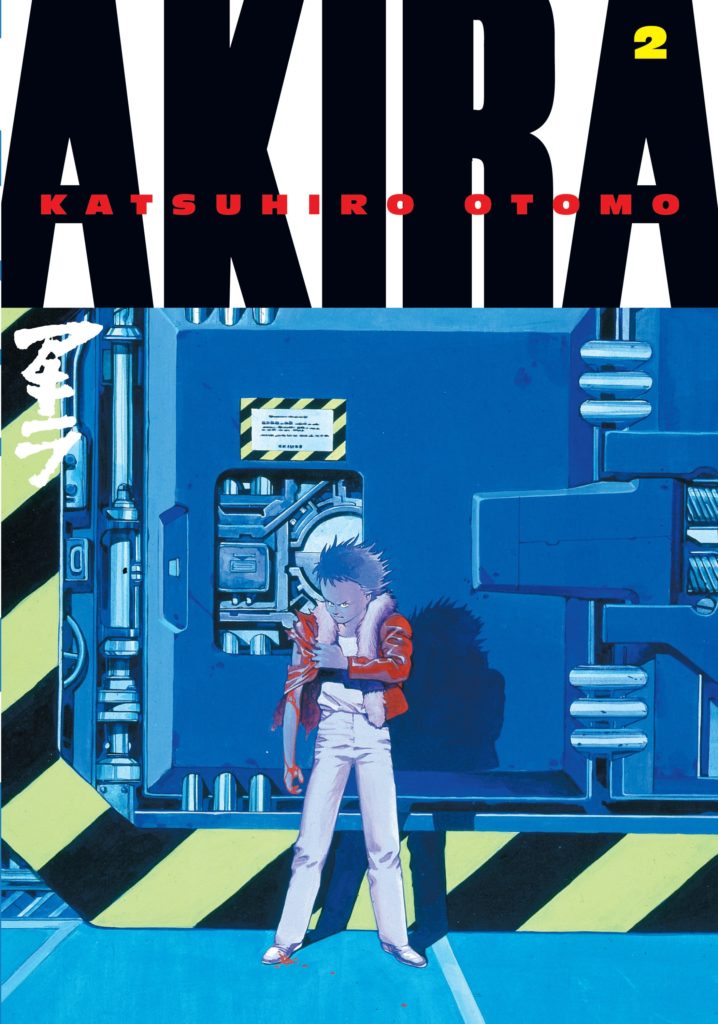
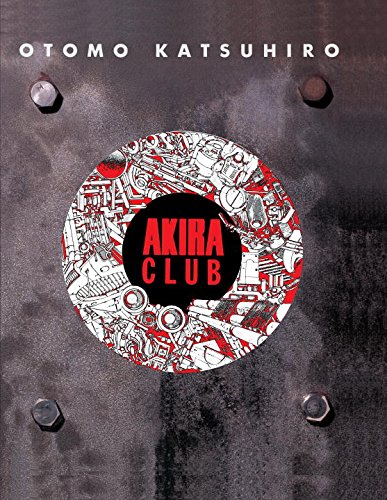
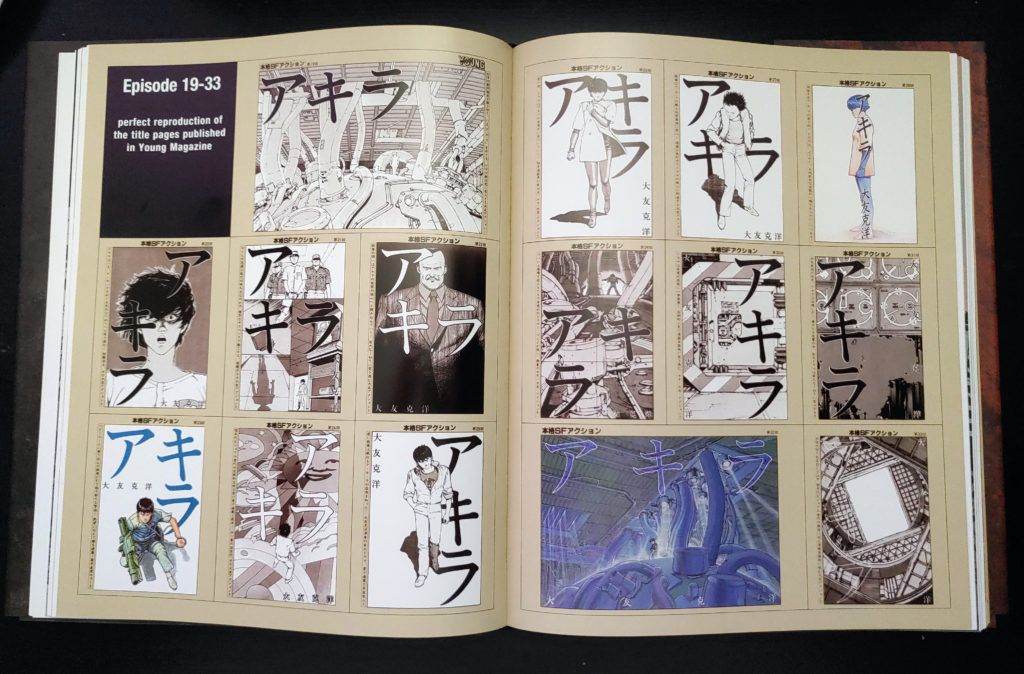
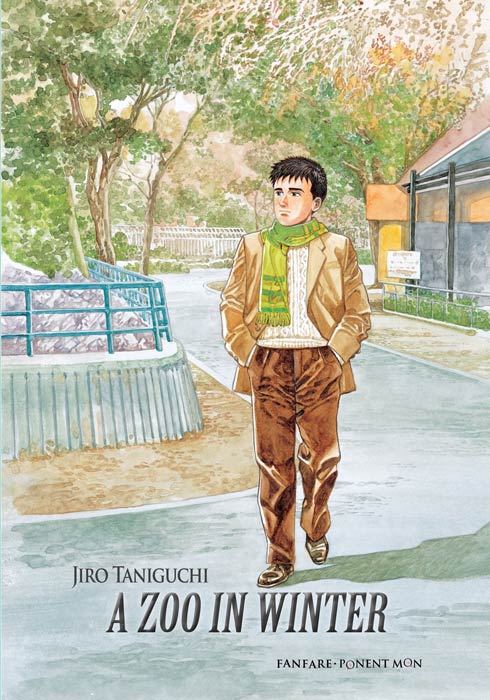
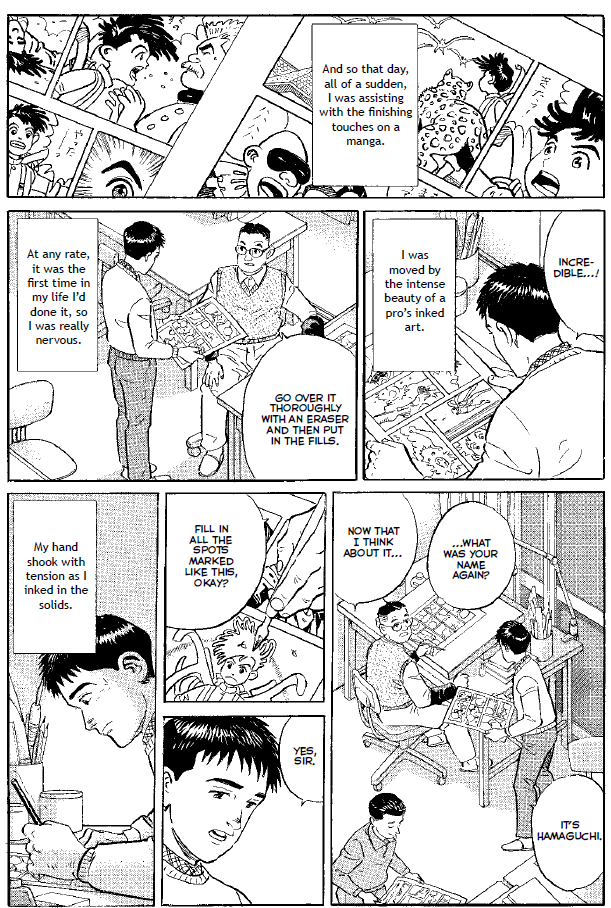
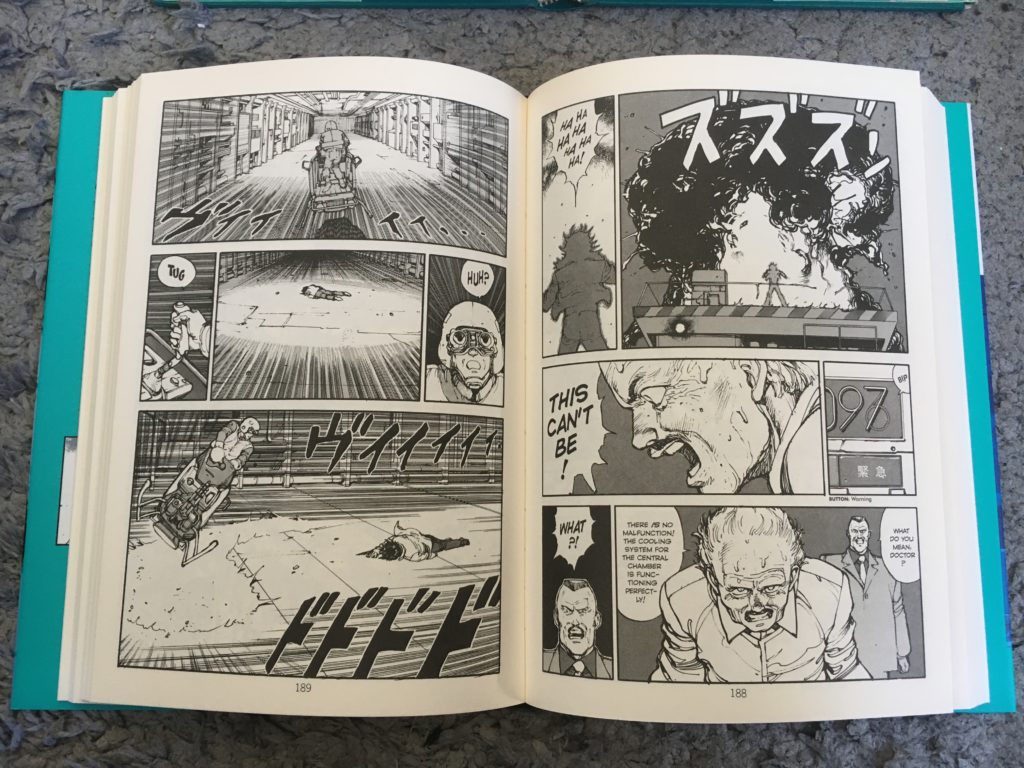
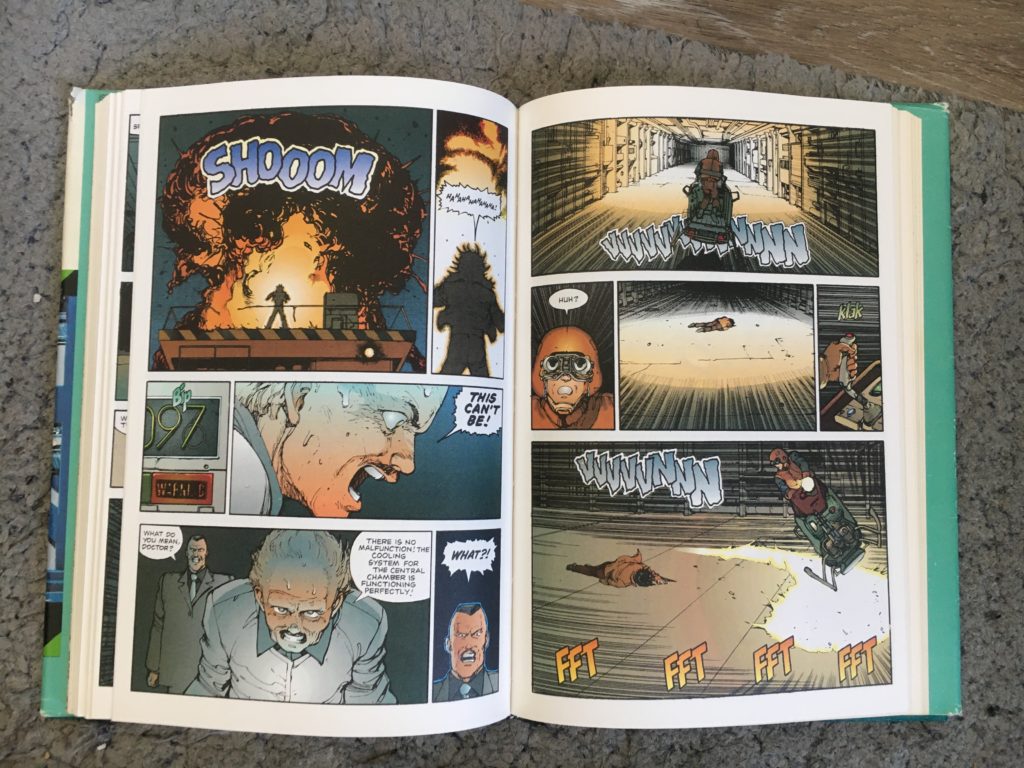
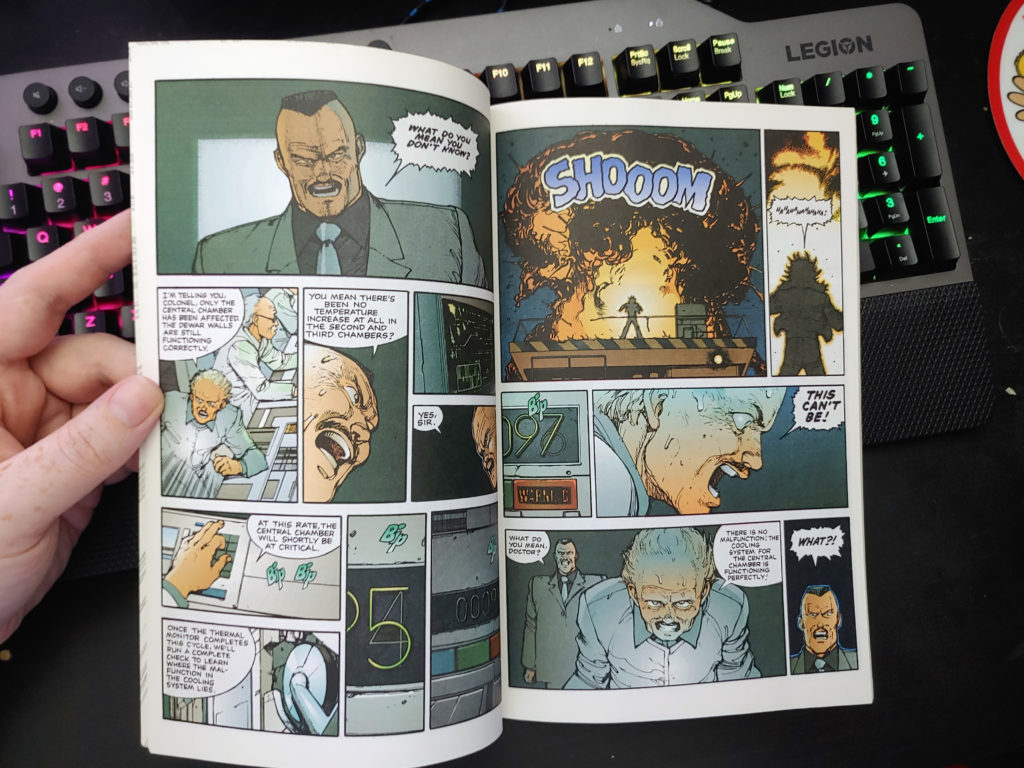
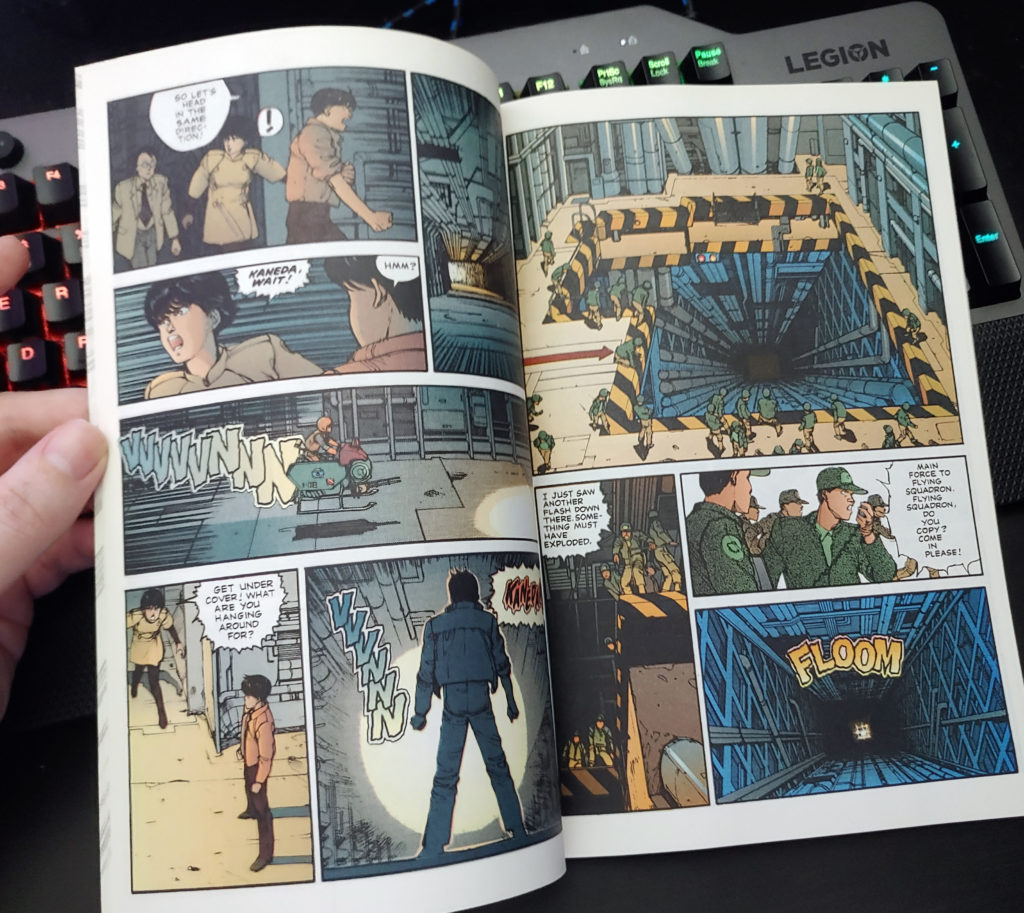
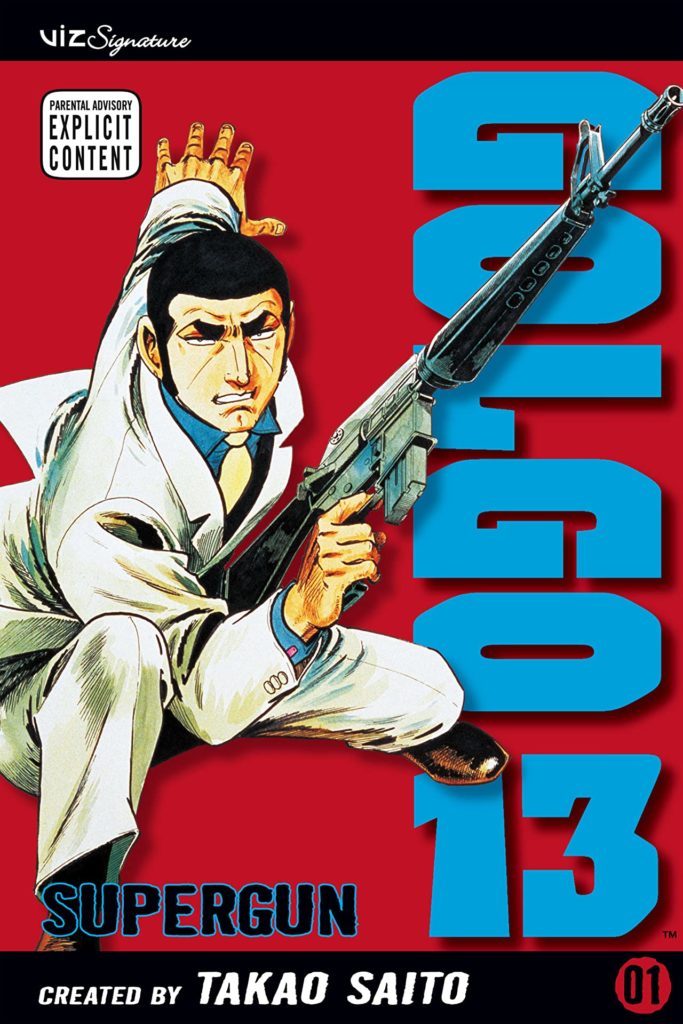
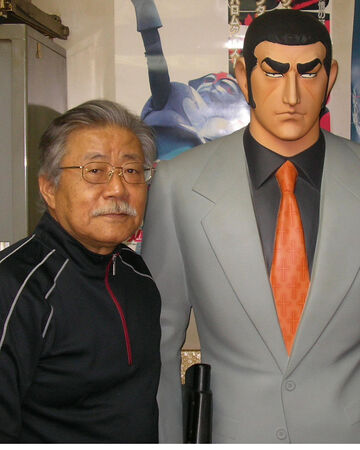
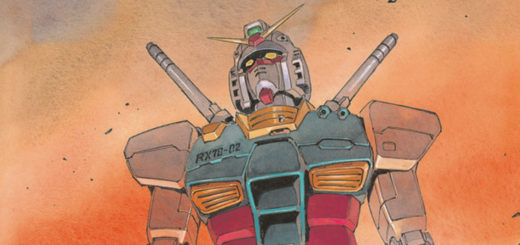
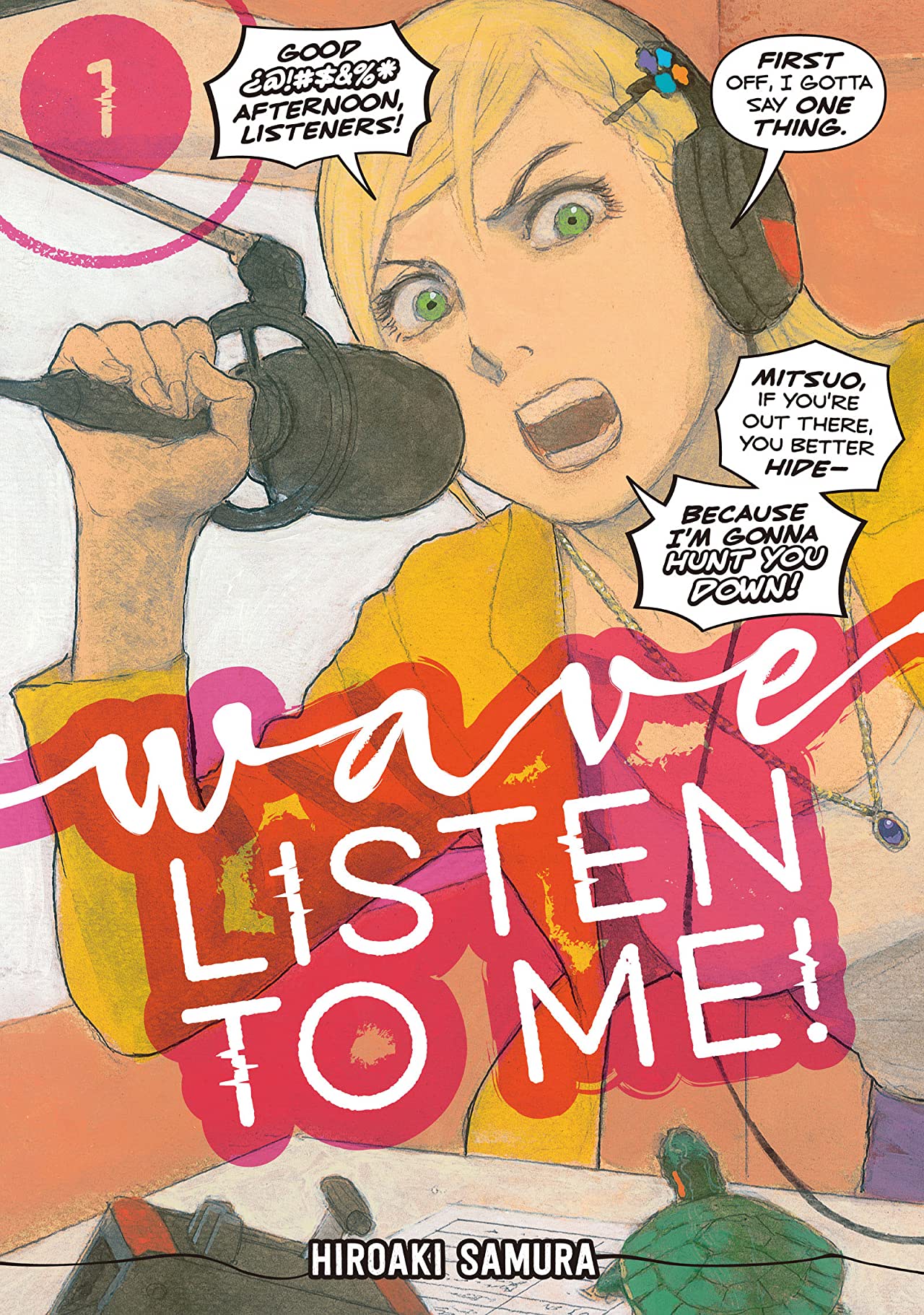
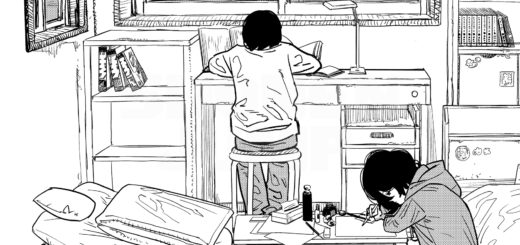
So, I’m only about half an hour in and I *have* to share a story.
In the late 1980’s I was in Wales and I swore to all the gods that I kept hearing the Doctor Who theme everywhere I went. It was exactly that cognitive dissonance you folks are talking about. I kept asking if my friends heard it and they just stared at me like I was crazy. It was everywhere – every grocery store, the laundromat…but only a short clip and then it was gone.
One day I was in the store and it was dead silent except for the muzak and there it was again! Finally my wife and friends heard it.
Turns out that ‘Doctorin’ the Tardis’ a mashup of Gary Glitter and Doctor Who was a huge hit on BBC radio that season. https://youtu.be/DsAVx0u9Cw4
It was exactly that same feeling – am I remembering wrong? Is this real? Two full weeks of my life walking around Wales and England thinking I was losing my mind.
Just totally excited that you’ll do Invitation for a Crab. I loved that – Rakuen Le Paradis magazine is sadly overlooked here in the US.
I was terrified of the Doctor Who theme as a kid, that would’ve been an awful visit to Wales for me. haha. 😉
Thanks for such an awesome first season, guys! You’ve reignited my love for manga (and also my pocket). Looking forward to the next season, please do Berserk and something from Urasawa-san!
Regarding the listener question, Eiichiro Oda has said that with One Piece he handles anything that is alive or moves, so characters but also clouds, water, smoke, etc.
Thanks for a great season one of the podcast!
That’s fascinating! I don’t think I’d heard that before. Thanks for the comment (and compliment!).
I’m so glad you came back to Akira again after Chip’s “semester” of Mangasplaining. Never have I wanted to interact with an episode so much as this one.
I’m surprised David has the Graphitti editions. When did he purchase them, and for how much? I’m pretty envious if he has them all and was able to find them without selling a kidney. I found volume 1 used for pretty cheap a few years back, which I think was a fluke, and, like Chris, was surprised that volume 4 was still available for the original price on Graphitti’s site. (I also availed myself of some signed Moebius collections while I was there.) As far as I know, Graphitti never published volume 6. Maybe because of the lag in Otomo and Epic completing Akira, or, given that volume 4 is still available, perhaps there was no financial incentive at the time. $50 was a few months of comics for me, so maybe it was just out of the price range of the average comics buyer and Graphitti wasn’t seeing that ROI.
You might be interested to note that that Marvel single issues of Akira were released in Japan in 3-issue packs, as is in English, with a pamphlet insert that has a literal Japanese translation of the English. It was not intended to be localized, otherwise they would have used the original text, but to help readers understand how the the story reads in English. A few years ago, more than 15 at this point, they were released as six volumes, with the Japanese translated inserted back into the pages. (If you do a search for “総天然色 AKIRA” you’ll see what they look like.) I remember at the time fans in Japan were upset because a high-quality edition of Akira had finally been released (it even had a boxed set), yet it was not the original Japanese but a hybrid version of the American edition. The only positive, they felt, was seeing Steve Oliff’s amazing colors, but otherwise they were disappointed with the package. And, yes, I checked to see if that bonus image was included to get the page ordering correct–and it is!
Just a note, those colorized endpapers are also in the Japanese version, but I can’t find any credit for who might have done them. Perhaps Otomo himself or one of his assistants?
As for the story, Kei’s possession by the children threw me the first time I read it, even though I should have expected that after seeing the movie. At first I had thought she had just had enough of Kaneda’s shit and just wanted to get the mission done, until we get to that scene we she’s completely oblivious to his safety. And that last panel with Tetsuo’s arm is one that will forever be emblazoned in my mind.
One interesting thing of note is that the movie “Short Peace” doesn’t actually feature any of the strips from Otomo’s “Short Peace” tankobon.
Anyway, thanks for doing another episode on Akira. You all were exhaustive in your explanations, and now, 25 episodes in, have all found your footing for this podcast. It was a such a great episode, and I can’t wait for season 2! Well, maybe my wallet can…
I have the original Marvel colorized versions of the story (took me years and years to collect and read them all as a kid in the ’80s/early ’90s, those things were EXPENSIVE on an allowance compared to other comics), and this podcast has finally inspired me to buy the fancy new B&W box set which I plan to dig into soon. I’m curious though, my original Marvel versions had a coloring error where the color printing was off by a a centimeter or two in one of the later issues (maybe 34? It was Ryu on the big ol’ elevator) and I’m curious if that was fixed in the Graphitti design edition.
You guys should keep doing one or two volumes a season, Akira is probably my favorite comic (to the extent I can pick just one), and I love listening to you guys chat about it. It’s one of those comics that really opened me up to new stuff. Also, would love to get Chip’s take on One Punch Man.
HELLO
So listening to you talk about Takao Saito shows to me that you haven’t watched Urasawas Manben show. You should. It owns. It’s as inspirational as brutal as you’d expect a manga drawing documentary series to be.